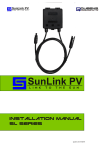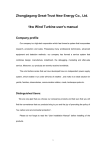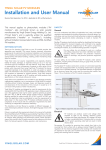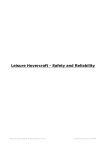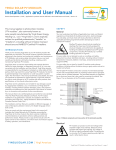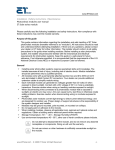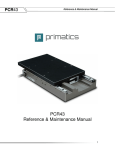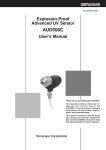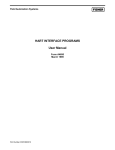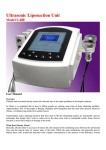Download SunLink PV
Transcript
SunLink PV Queens HONGKONG CO LTD link to the sun SunLink PV link to the sun Installation Manual SL Series queens rev III/2014 SunLink PV Queens HONGKONG CO LTD link to the sun Index INTRODUCTION WARNING NOTICES 3 4 GENERAL SAFETY HANDLING SAFETY INSTALLATION SAFETY FIRE SAFETY 5 5 6 7 SITE SELECTION AVOID OVERSHADOWING RELIABLE VENTILATION TILT ANGLE SELECTION 7 7 7 7 ELECTRICAL INSTALLATION 8 CONNECTORS BYPASS DIODES GROUNDING 8 8 8 MECHANICAL INSTALLATION 9 GENERAL MOUNTING AND INSTALLATION 9 9 ELECTRICAL CHARACTERISTICS 11 MAINTENANCE 11 GENERAL CLEANING DECOMMISSIONING 11 11 11 USER MANUAL 12 Explanation of coding of serial numbers SL XXX X XXXXXX XXXX type P/M Batch number serial number SL Type r Serial number 1-2 bits signify company name SL 3-5 bits signify Type, such as (said 220,280) 6 bits signify that the battery piece types: P represent Polycrystal, M represent monocrystal 7-12 bits signify production batches: example: 1006YA. 13-16 bits signify serial number queens rev III/2014 SunLink PV Queens HONGKONG CO LTD link to the sun Introduction Thank you for choosing a Sunlink PV photovoltaic (PV) module. This manual contains information regarding the safe installation and handling of photovoltaic (PV) modules produced byJiangSu Sunlink PV Technology Co., Ltd, (“Sunlink PV”). This manual contains important safety instructions for the PV module that must be followed during the installation and the maintenance of PV modules. Failure to follow these instructions may result in bodily injury or damage to property. Working on a photovoltaic system requires specialized knowledge and should only be attempted by qualified professionals. All the instructions given in this manual should be read carefully and understood before attempting to install the modules. This manual does not constitute a warranty, expressed or implied. Sunlink PV Solar does not assume responsibility and expressly disclaims liability for loss, damage, or expense arising out of or in any way connected with installation, operation, use or maintenance of PV modules. No responsibility is assumed by Sunlink PV Solar for any infringement of patents or other rights of third parties that may result from use of PV modules. Failure to comply with the requirements listed in this manual will invalidate the Limited Warranty for PV Modules as provided by Sunlink PV. Please provide a copy of this manual to the PV system owner for their reference, and inform them of all relevant aspects of safety, operation, and maintenance. Sunlink PV Solar reserves the right to make changes to the product, specifications or installation manual without prior notice. queens rev III/2014 3 of 1 2 SunLink PV link to the sun Queens HONGKONG CO LTD warning notices DANGER OF DEATH FROM ELECTRIC SHOCK PV modules can produce current and voltage when exposed to light of any intensity. Electrical current increases with higher light intensity. DC voltage of 30 Volts or higher is potentially lethal. Contacting the live circuitry of a PV system operating under light can result in lethal electric shock. When handling the module the following must be followed to avoid the risk of arcing, fire and electric shock. 1 De-energize PV modules by removing them entirely from light or by covering their front surface with an opaque material. 2 Regard the safety regulations for live electrical equipment when working with modules that are exposed to any light. 3. Do not install PV modules when wet. Tools must be dry. 4. Do not use damaged or defective modules. Place all damaged or defective modules in a carton to avoid exposure to light. Even damaged or defective modules can produce electricity. 5. Contact with electrically active parts of a PV module such as terminals, can result in burns, sparks and lethal shock whether the PV modules are connected or not. 6. PV systems can produce high voltage and current which could present an increased hazard and may cause serious injury or death. 7. Artificial sunlight should not be concentrated upon the PV module. Do not expose PV modules to sunlight concentrated with mirrors, lenses or other means. 8. Use appropriate safety equipment (insulated tools, insulated gloves, etc) when working on any wiring. 9. Do not wear metallic jewelry when installing. 10. The installation of PV should only be performed by qualified personnel. DANGER OF DEATH FROM ELECTRIC SHOCK The inverter can produce dangerous, high voltage. 1. Be sure to follow all manufacturers’ instructions before installing any PV modules. 2. Use extreme caution when wiring or installing inverter. 3. Be sure to shut down inverter before installing or removing PV modules. DANGER OF DEATH FROM ELECTRIC SHOCK When exposed to light, PV modules produce direct current. When disconnecting any PV modules from a string, a deadly arc can occur. 1. Never remove a PV module without disconnecting the inverter from the grid 2. Never remove the PV module without disconnecting the PV system from the inverter. 3. Make sure that the connectors are in good working condition and are properly connected to each other. queens rev III/2014 4 of 1 2 SunLink PV Queens HONGKONG CO LTD link to the sun General Safety You must understand and follow all applicable local, state, and federal regulations and standards for building construction, electrical design, fire, and safety, and must check with local authorities to determine applicable permitting requirements before attempting to install or maintain PV modules. Rooftop PV systems should only be installed on dwellings that have been formally analyzed for structural integrity, and confirmed to be capable of handling the additional weighted load of PV system components, including PV modules, by a certified building specialist or engineer. For your safety, do not attempt to work on a rooftop until safety precautions have been identified and taken, including without limitation fall protection measures, ladders or stairways, and personal protective equipment(PPE). respect the folowing rules 1. Wiring and grounding method of the frame of arrays shall comply with national, regional and local codes, laws and standards. 2. PV modules should be installed and maintained by qualified personnel. Only installation/service personnel should have access to the PV module installation site. 3. Keep children away from PV modules. 4. Prior to installation, do not store modules outdoors or in a damp environment to prevent glass from damage due to white efflorescence. 5. Roof mounted PV modules are to be mounted over a fire resistant roof. 6. Only PV modules with the same cell type and size should be connected in series. 7. Follow all safety precautions of other components used in the system. 8. Avoid uneven shade on the PV module surface. Shaded cells may become hot(“hotspot” phenomenon) which may result in permanent damage to the module. 9. Do not use high pressure water spray or chemicals to clean the PV modules. 10. Turn off inverters and circuit breakers immediately, should a problem occur. 11. Place defective PV modules in cartons so PV cells are completely shaded, because a defective PV module or module with broken glass may generate power even if it is removed from the system. 12. To avoid dirt accumulation or white efflorescence due to water accumulation, do not install PV modules horizontally (flat). 13. In case of snow build up, snow would be slide down easier on the module than other parts of the roof. When snow suddenly slide and fall off the module’s surface, it may fall to under the roof and reach nearby areas. Ensure that the installment of the modules would not cause any damage to objects (carport, bicycle, entrance) nearby. 14. Apply appropriate safety measures and/or safety equipments (e.g. snow stopper) when necessary. 15. Do not expose PV modules to sunlight concentrated with mirrors, lenses or other means. 16. Turn off inverters and circuit breakers immediately, should a problem occur. 19. The maximum open circuit voltage must not be greater than the specified maximum system voltage. Voltage is proportional to the number of PV modules in series and is affected by weather conditions. 19. For strings connected in parallel take proper measures to block reverse current flow. Handling Safety 1. Do not expose the PV module to excessive loads on the surface of the PV module or twist the frame. The glass may break. 2. Do not sit, stand, step or walk on any side of the module, including the frames. The glass may be slippery, and there is a risk of injury or electric shock if glass is broken. 3. Do not hit or put excessive load on the glass or back sheet. PV cells may break. 4. Do not lift the module by grasping the module’s junction box or electrical leads. 5. Do not place any heavy objects on the module. 6. To avoid damage to the back sheet, do not scratch or hit the back sheet. 7. Do not drop the PV module or allow objects to fall on the PV module. 8. Avoid the connector from scratching or impacting the back sheet of the module. 9. Install connector such that it is not exposed to direct sunlight. 10. Do not twist the interconnect cable excessively. 11. Never touch the end of the interconnect cables with bare hands when the module is illuminated. Cover the surface of module with cloth or other sufficiently opaque material to block the module from incident light and handle the wires with insulated gloved hands to avoid electric shock. queens rev III/2014 5 of 1 2 SunLink PV link to the sun 12. Do not drill holes in the frame. It may compromise the frame strength and cause corrosion of the frame and void the warranty. 13. To avoid damage to the backsheet and cells, do not scratch, dent or hit the backsheet. During the transportation, do not to apply direct pressure on the backsheet 14. Do not apply paint or adhesive to the module top surface or backsheet. 15. Do not touch the PV module with bare hands. The frame of the PV module has sharp edges and may cause injury. Wear suitable gloves, such as leather gloves with padding in the palm and finger areas. 16. A panel with broken glass or torn backsheet cannot be repaired and must not be used since contact with any panel surface or the frame can cause an electric shock. 17. Do not lift the PV module by only one side. The frame may bend microcracking will be create. 18. Always use two hands to lift and carry the PV module on the long side of the frame. 20. Work only under dry conditions, and use only dry tools. Do not handle panels under wet conditions unless wearing appropriate protective equipment. 21. When storing uninstalled panels outdoors for any period of time, always cover the panels and ensure that the glass faces down on a soft flat surface to prevent water from collecting inside the panel and causing damage to exposed connectors. 22. Transport modules in an upright position. 23. Ensure modules do not bow under their own weight. 24. Do not place modules on top of each other. 25. Do not subject to load, do not stand on them. 26. Do not mark using sharp implements. 27. Keep all electrical contacts clean and dry. Installation safety 1. Installing solar PV systems requires specialized skills and knowledge. 2. Always wear protective head gear, insulating gloves and safety shoes (with rubber soles). Queens HONGKONG CO LTD 3. Do not touch the PV module unnecessarily during installation. The glass surface and the frame may be hot. There is a risk of burns and electric shock. 4. One individual module may generate DC voltages greater than 30 V when exposed to light of any intensity. Contact with a DC voltage of 30 V or more is potentially hazardous. 5. PV modules will generate electricity whilst exposed to light. Generation will only stop when the PV module is link to the sun either removed from light or covered with a dark opaque material. When working with modules without any cover, regard the safety regulations for live electrical equipment. 6. Contact with electrically charged parts of the panels, such as terminals, can result in burns, sparks and lethal shock whether or not the panel is connected. 7. Keep the PV module packed in the carton until installation. 8. Do not work in rain, snow or windy conditions. 9. Due to the risk of electrical shock, do not perform any work if the terminals of the PV module are wet. 10. Use insulated tools and do not use wet tools. 11. Never open electrical connections or unplug connectors while the circuit is under load. 12. Insert interconnect connectors fully and correctly. Check all connections. Cables should be secured to the PV module frames, support structure or raceway to prevent movement. Keep connectors out of direct sunlight in order to prevent insulation degradation. 13. To avoid electrical arcing, do not disconnect modules under load. 14. Do not touch the terminal box and the end of the interconnect cables with bare hands during installation or under sunlight, regardless of whether the PV module is connected to or disconnected from the system. 15. Do not damage the back sheet of PV modules when mounting the PV modules. 16. Do not damage the surrounding PV modules or mounting structure when replacing a PV module. 17. Keep children well away from the system while transporting and installing mechanical and electrical components. 18. Use only insulated tools that are approved for working on electrical installations. 19. Do not wear metallic rings, watchbands, earrings, nose rings, lip rings or other metallic objects while installing or troubleshooting photovoltaic systems. 20. Make sure flammable gasses are not generated or present near the installation site. queens rev III/2014 6 of 1 2 SunLink PV link to the sun 21. The interconnect cable should be securely fastened to the module frame, the mounting racking or in a raceway to prevent movement of the interconnect cable over time. Cable support should be done in a way to avoid the connector from scratching or impacting the back sheet of the module. Drooping cables may cause various problems, such as leading to electrical shorts. 22. Do not unplug a connector if the system circuit is connected to an operating load. 23. Do not work alone (always work as a team of 2 or more people) 24. Wear a safety harness when working above the ground. 25. Follow the safety regulations(eg. safety rules for working on electrical power plant stations) for all other system components, including wires and cables, connectors, charging regulators, inverters, storage batteries, rechargeable batteries, etc. 26. hen installing PV modules on roofs or other structures, the appropriate safety practices and safety equipment should be used at all times to avoid injury. 27. Only use same or connectable connectors to connect modules to form a string, or connect to another device. Removing the connectors will void the warranty. 28. Take proper measures for preventing the laminate (consisting of encapsulant, cells, glass, back sheet, etc.) from dropping out of the frame in case the glass is broken. 29. In case of extreme snow build-up, the weight of the snow may causes the module’s frame to deform. Take appropriate measures to minimize any possible resulting damage. 30. It is recommended to install the PV module with the junction box at the highest point. 31. Always use the same type of module within a particular PV system. 32. Do not attempt to repair any part of the PV module. Fire Safety 1. Consult your local authority for guidelines and requirements for building or structural fire safety. 3. Roof constructions and installations may affect the fire safety of a building; 4. improper installation may create hazards in the event of a fire. 5. Use components such as ground fault circuit breakers and fuses as required by local authority. 7. Do not use panels near equipment or in places where Queens HONGKONG CO LTD flammable gases may be generated. 9. The modules have been rated Fire Class C, and are suitable for mounting on to a Class A roof. Site Selection PV modules are intended for outdoor use only and not intended for use on any mobile applications (except solar trackers). Take proper steps in order to maintain reliability and safety in case the PV modules are installed in areas that have heavy snow /extreme cold / strong winds / installations over, or near, water and areas where installations are prone to salt water exposure or on small islands or in desert areas. If you are planning to use the PV modules where salt water damage may occur, please consult with us to determine an appropriate installation method, or if installation is possible. Any other type of corrosive agent could affect the performance and/or safety of the PV modules. Avoid overshadowing Avoid trees, buildings or other obstacles that can cast shadows on the modules. Even the slightest partial shading (e.g. from dirt deposits) will cause a reduction in yield. A module is considered “shadow-free” if it is unobscured across its entire surface for the whole year and even on the shortest day of the year unobstructed sunlight can reach the module. Shaded cells may become hot (“hotspot” phenomenon) which may result in permanent damage to the module. Reliable ventilation Provide adequate ventilation under a module for cooling, we recommends 10 cm minimum air space between module and mounting surface. Sunlink PV recommends that PV modules are mounted at a minimum tilt angle of 10° (when this not in contrast with the best tilt angle for your location) with respect to the horizon, in order to facilitate the selfcleaning of their front glass from dirt during ordinary raining. TILT ANGLE SELECTION Sunlink PV modules produce the most power when the sun’s rays strike the module perpendicular to the module queens rev III/2014 7 of 1 2 SunLink PV link to the sun surface. To avoid performance losses in series circuits, ensure that all modules have the same tilt and orientation. Your solar professional will be able to determine the best tilt angle for your location. ELECTRICAL INSTALLATION To ensure proper system operation and maintain the warranty, be careful to observe the correct cable connection polarity when connecting the modules to a battery or to other modules. If not connected correctly, the bypass diode(s) could be destroyed. All PV modules must be grounded by electrical connection of the module frames to ground. and locked Queens HONGKONG CO LTD Bypass Diodes The junction boxes used with Sunlink PV modules contain bypass diodes wired in parallel with the PV cell strings. In the case of partial shading, the diodes bypass the current generated by the non-shaded cells, thereby limiting module heating and performance losses. Bypass diodes are not overcurrent protection devices. Bypass diodes divert current from the cell strings in the event of partial shading. In the event of a known or suspected diode failure, installers or maintenance providers should contact the company the PV modules were purchased from. Never attempt to open the junction box of a PV module yourself. Care must be taken to arrange the system ground so that the removal of one module from the circuit will not interrupt the grounding of any of the other modules.In the event of a known or suspected diode failure, installers or Grounding maintenance providers should contact the company the PV modules were purchased from. Several different methods of grounding can be used to Never attempt to open the junction box of module provide the required connection through the frame yourself. anodizing. Before installation contact the local code Authority Having Voltages are additive when PV modules are connected directly in series, and module currents are additive when Jurisdiction to determine the proper grounding requirements. PV modules are connected directly in parallel. The frame of the PV module, as well as any exposed nonPV modules with different electrical characteristics must current-carrying metal parts of fixed equipment that are not be connected directly in series. able to become energized by the PV system, must be connected to the equipment grounding conductor in order The use of suitable third-party electronic devices to prevent electrical shock. connected to PV modules may enable different electrical Even when applicable regulations, code requirements, connections and must be installed according to the and standards do not require safety-related grounding, Sunlink PV recommends grounding all PV module frames in order to ensure the voltage between electrically Connectors conductive equipment and earth ground is zero in all circumstances Keep connectors dry and clean, and ensure that Although the modules are certified to safety class , we connector caps are hand tight before connecting the still recommend earthing them. modules. Do not attempt making an electrical connection with wet, The earth connection should be made by a qualified electrician. soiled, or otherwise faulty connectors. All the crunodes on the conductive connection must be Avoid sunlight exposure and water immersion of the fixed. The fastness does not depend on soldering. The connectors. metal containing iron in the conductive connection should Avoid connectors resting on the ground or roof surface. Faulty connections can result in arcs and electrical shock. be handled by some way, such as anodization, sprayCheck that all electrical connections are securely fastened. painting, galvanization. Stainless steel does not need to be handled. manufacturer’s specified instructions. Make sure that all locking connectors are fully engaged queens rev III/2014 8 of 1 2 SunLink PV Queens HONGKONG CO LTD link to the sun MECHANICAL INSTALLATION General Sunlink PV Modules have been certified for a maximum static load on the back of the module of up to 2400 Pa (i.e. wind load) and a maximum static load on the front of the module of up to either 2400 Pa or 5400 Pa (i.e. wind and snow load), depending on the module type (please refer to the data sheet for this information). For roof mounted systems we recommends 10 cm minimum air space between module and mounting surface and Provide adequate ventilation under a module for cooling, The modules may be fastened to a support using the bolt holes in the bottom of the frame shown in Figure 1. The module should be fastened at four points, with a M8 bolt, washers and a nut (not provided). Mounting structures and other mechanical parts must be Inter-module type or end-type clamps must be designed designed and approved to withstand the design wind and for PV modules and have minimum dimensions shown in snow loads applicable for a particular site. Figure 2 and installed in accordance with the instructions below and drawings provided. Modules must not be subjected to forces from the substructure, including forces caused by thermal When installing, the clamp must overlap the support rail expansion. by at least 10 mm and be placed within the permissible clamping zones shown in Figure 3. For the high load The mounting method must not result in the direct contact situations shown in Figure 3 an additional center support of dissimilar metals with the aluminum frame of the PV rail should be used. module that will result in galvanic corrosion. An addendum to UL Standard 1703 “Flat Plate Photovoltaic Modules and Panels” recommends metal combinations not exceed an electrochemical potential difference of 0.5 Volts. In order to maintain the fire class rating, the distance between the PV module front surface (glass) and the roof surface shall be at least 10 cm. Note that Sunlink PV does not warranty frame clamps. The Sunlink PV module warranty may be void if customerselected frame clamps are improper or inadequate with respect to properties (including strength or material) or installation. This spacing also allows air flow to cool the PV module. Install PV modules with a minimum spacing of 1 cm between neighboring frames to allow for thermal expansion. Mounting and Installation There are several ways to mount the Sunlink PV modules to a support structure. They may be mounted in either portrait or landscape orientation using either the bolt holes provided or using frame clamps (not provided). For all mounting methods a minimum gap of 7 mm between modules is required to allow for thermal expansion. fig. 1 Bolt fig. 2 Clamp queens rev III/2014 9 of 1 2 SunLink PV link to the sun fig 3. Queens HONGKONG CO LTD Attachment guide lines queens rev III/2014 1 0 of 1 2 SunLink PV Queens HONGKONG CO LTD link to the sun Maximum number of modules in parallel and in series When designing the system, we recommend that the maximum number of modules in parallel should be no more than 2 while the maximum number of modules in series no more than 22 Electrical Characteristics please refer to the data sheet for any information about single module. MAINTENANCE General Sunlink PV recommends that PV systems be periodically inspected by the installer, or other qualified person. The purpose of the PV system inspection is to ensure that all system components are functioning properly. At a minimum, this inspection should confirm the following: 1. All cables and connector attachments are undamaged and properly secured 2. No sharp objects are in contact with the PV module surfaces 3. PV modules are not shaded by unwanted obstacles and/or foreign material 4. Mounting and grounding components are tightly secured with no corrosion 5. Do not touch the glass since finger prints or stains will easily mark the glass. 6. check all wiring connections and the condition of the wire insulation periodically Defects should be addressed immediately. Cleaning Over time, dirt and dust can accumulate on the glass surface of the module, reducing its power output. Sunlink Pv recommends periodic cleaning of PV modules to ensure maximum power output, especially in regions with low precipitation. In order to reduce the potential for electrical and thermal shock, we recommends cleaning PV modules during early morning or late afternoon hours when solar radiation is low and the modules are cooler, especially in regions with hotter temperatures. Never attempt to clean a PV module with broken glass or other signs of exposed wiring, as this presents a shock hazard. Clean the glass surface of the PV modules with a soft brush using soft, clean water with a recommended pressure less than 690kPa, which is typical of most municipal water systems. Water with high mineral content may leave deposits on the glass surface and is not recommended. Sunlink PV modules may contain a hydrophobic antireflective coating on the glass surface to enhance power output and reduce dirt and dust buildup. In order to avoid module damage, do not clean PV modules with a power washer or pressure washer. Do not use steam or corrosive chemicals to facilitate the cleaning of modules. Do not use aggressive tools or abrasive materials that could scratch or damage the glass surface. Failure to comply with these requirements may adversely affect the PV module performance. Sunlink PV modules are designed to withstand high snow loads. However, if removing snow is desired to enhance production, use a brush to gently remove snow. Do not try to remove frozen snow or ice from PV DECOMMISSIONING The dismantling of PV systems must be performed with the same care and safety precautions used during the initial installation. The PV system can generate hazardous voltage even after the system has been disconnected. Follow safety regulations for working with live electrical equipment. modules. queens rev III/2014 1 1 of 1 2 SunLink PV Queens HONGKONG CO LTD link to the sun USER MANUAL IMPORTANT SAFETY INSTRUCTIONS This manual contains important safety instructions for the PV module that must be followed during the maintenance of PV modules. 1. To reduce the risk of electric shock, do not perform any servicing unless you are qualified to do so. 2. The installation must be performed by a certified installer/servicer to ensure system integrity and safety. 3. Do not pull the PV cables. 4. Do not touch any surface of module. 5. Do not place/drop objects onto the PV modules. 6. Do not disassemble or attempt to repair the PV module by yourself. 7. Do not drop the PV module. 8. Do not damage, pull, bend, or place heavy material on cables. 9. Upon completion of any service or repairs, ask the installer/servicer to perform routine checks to determine that the PV modules are in safe and proper operating condition. 10. When replacement parts are required, be sure the installer/servicer uses parts specified by the manufacturer with same characteristics as the original parts. Unauthorized substitutions may result in fire, electric shock, or other hazard. 11. Consult your local building and safety department for required permits and applicable regulations. Jiangsu SunLink PV Technology Co., Ltd Add: Nanyuan Road, Economic Development Zone Zhangjiagang City, Jiangsu Province 215600 P.R. China Phone: +8651258166568 Fax: +8651258166560 Web: www.sunlinkpv.com Hong Kong Queens Imports & Exports Co., LTD. technical department ROOM 1605A, HO KING COMMERCIAL CENTRE,216 FA YUEN STREET,MONGKOK, KOWLOON, HONG KONG tel 0085230697060 fax 0085269917688 www.mqqueens.com queens rev III/2014 1 2 of 1 2












